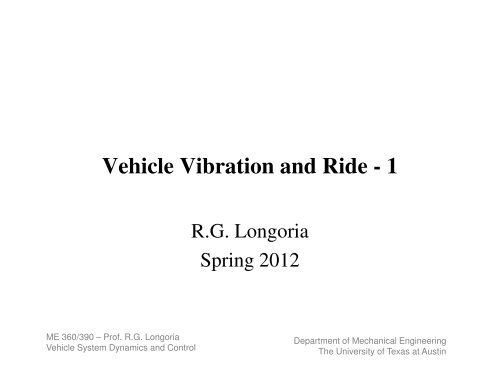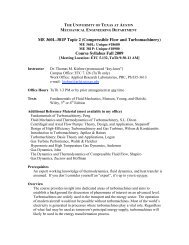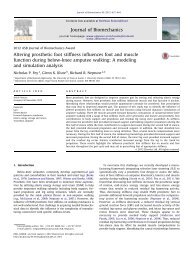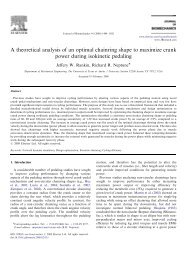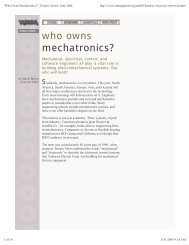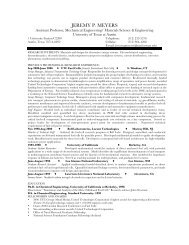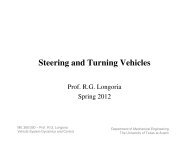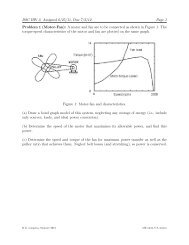Vehicle Vibration and Ride - Department of Mechanical Engineering ...
Vehicle Vibration and Ride - Department of Mechanical Engineering ...
Vehicle Vibration and Ride - Department of Mechanical Engineering ...
Create successful ePaper yourself
Turn your PDF publications into a flip-book with our unique Google optimized e-Paper software.
<strong>Vehicle</strong> <strong>Vibration</strong> <strong>and</strong> <strong>Ride</strong> - 1<br />
ME 360/390 – Pr<strong>of</strong>. R.G. Longoria<br />
<strong>Vehicle</strong> System Dynamics <strong>and</strong> Control<br />
R.G. Longoria<br />
Spring 2012<br />
<strong>Department</strong> <strong>of</strong> <strong>Mechanical</strong> <strong>Engineering</strong><br />
The University <strong>of</strong> Texas at Austin
ME 360/390 – Pr<strong>of</strong>. R.G. Longoria<br />
<strong>Vehicle</strong> System Dynamics <strong>and</strong> Control<br />
Overview<br />
• 1 DOF ¼-car ride model<br />
• Terrain descriptions for vibration<br />
• R<strong>and</strong>om excitation <strong>of</strong> ¼-car model<br />
• 2DOF ¼-car ride model<br />
• Appendix A (base-excited models)<br />
• Appendix B (human response to vibration)<br />
<strong>Department</strong> <strong>of</strong> <strong>Mechanical</strong> <strong>Engineering</strong><br />
The University <strong>of</strong> Texas at Austin
Sources <strong>of</strong> <strong>Vibration</strong> <strong>and</strong> Noise<br />
Interaction <strong>of</strong> a ground vehicle with,<br />
– road roughness<br />
– aerodynamic forces<br />
– engine <strong>and</strong> driveline dynamics<br />
– tire/wheel assembly imbalance dynamics<br />
can induce vehicle body vibration <strong>and</strong> noise.<br />
ME 360/390 – Pr<strong>of</strong>. R.G. Longoria<br />
<strong>Vehicle</strong> System Dynamics <strong>and</strong> Control<br />
<strong>Department</strong> <strong>of</strong> <strong>Mechanical</strong> <strong>Engineering</strong><br />
The University <strong>of</strong> Texas at Austin
ME 360/390 – Pr<strong>of</strong>. R.G. Longoria<br />
<strong>Vehicle</strong> System Dynamics <strong>and</strong> Control<br />
<strong>Ride</strong> <strong>and</strong> Noise<br />
• <strong>Ride</strong> quality refers to<br />
– the sensation or feel <strong>of</strong> the passenger<br />
– tactile <strong>and</strong> visual vibrations in frequency range from 0 to 25<br />
Hz (low)<br />
• Noise refers to<br />
– aural vibrations<br />
– frequency range 25 to 20,000 Hz (high)<br />
• <strong>Ride</strong> <strong>and</strong> noise are perceived differently by humans, so<br />
there is a need to adopt methods that help quantify <strong>and</strong><br />
control.<br />
• See Appendix B for more on human response (ref.<br />
Wong, Ch. 7).<br />
<strong>Department</strong> <strong>of</strong> <strong>Mechanical</strong> <strong>Engineering</strong><br />
The University <strong>of</strong> Texas at Austin
A ¼ car model can help build insight<br />
Isolation <strong>of</strong> the body from the forces generated by the ground unevenness - tire<br />
provides some help in this respect (ride control)<br />
Control <strong>of</strong> tire normal forces on the ground - by following the ground surface, the tires<br />
will have traction <strong>and</strong> lateral control (road holding control)<br />
Karnopp <strong>and</strong> Heess (1991)<br />
ME 360/390 – Pr<strong>of</strong>. R.G. Longoria<br />
<strong>Vehicle</strong> System Dynamics <strong>and</strong> Control<br />
Wong (2001)<br />
<strong>Department</strong> <strong>of</strong> <strong>Mechanical</strong> <strong>Engineering</strong><br />
The University <strong>of</strong> Texas at Austin
Key analysis can begin with even simpler system<br />
models illustrating isolation function<br />
You can show that:<br />
The frequency response tells us how the<br />
amplitude or phase <strong>of</strong> the response will<br />
depend on the frequency <strong>of</strong> the forcing<br />
function, y(t) (which we can relate to the<br />
terrain pr<strong>of</strong>ile, y(x), <strong>and</strong> the forward<br />
velocity, V).<br />
ME 360/390 – Pr<strong>of</strong>. R.G. Longoria<br />
<strong>Vehicle</strong> System Dynamics <strong>and</strong> Control<br />
2 2<br />
Z ks + ( ωb)<br />
Zɺ<br />
= =<br />
2 2 2<br />
Y ( k − mω ) + ( bω) Yɺ<br />
Zɺ<br />
Yɺ<br />
Underst<strong>and</strong>ing <strong>of</strong> transfer<br />
functions <strong>and</strong> frequency<br />
response is essential.<br />
Good isolation<br />
<strong>Department</strong> <strong>of</strong> <strong>Mechanical</strong> <strong>Engineering</strong><br />
The University <strong>of</strong> Texas at Austin
The ¼-car model can provide insight into several<br />
key measures <strong>of</strong> vehicle ride<br />
These measures are discussed in Wong (2001) <strong>and</strong> summarized in notes provided<br />
on <strong>Vehicle</strong> <strong>Ride</strong>.<br />
Transmissibility Ratio<br />
mus<br />
mass ratio =<br />
m<br />
TR ( 2 ⋅π ⋅f , 0.05)<br />
2<br />
TR ( 2 ⋅π ⋅f , 0.10)<br />
2<br />
TR ( 2 ⋅π ⋅f , 0.20)<br />
2<br />
TR ( 2 ⋅π ⋅f , 0.75)<br />
2<br />
ME 360/390 – Pr<strong>of</strong>. R.G. Longoria<br />
<strong>Vehicle</strong> System Dynamics <strong>and</strong> Control<br />
s<br />
0.01<br />
1 . 10 3<br />
1 . 10 4<br />
10<br />
1<br />
0.1<br />
A lighter unsprung mass<br />
provides better vibration<br />
isolation in the midfrequency<br />
range.<br />
Varying mass ratio<br />
0.1 1 10 100<br />
f<br />
Frequency (Hz)<br />
At higher frequencies,<br />
you may ‘feel’ more<br />
with lighter unsprung<br />
mass.<br />
The 1/4 car model is also helpful in introducing the role that controllable or<br />
active elements can play in vehicle suspensions.<br />
<strong>Department</strong> <strong>of</strong> <strong>Mechanical</strong> <strong>Engineering</strong><br />
The University <strong>of</strong> Texas at Austin
Overview <strong>of</strong> <strong>Vibration</strong> Models<br />
• 1 DOF: “Base Excitation” – to guide initial<br />
model formulation<br />
• Road surface pr<strong>of</strong>iles – to underst<strong>and</strong> how you<br />
specify road-induced excitation<br />
• 2 DOF: ¼-car Model – the ‘st<strong>and</strong>ard’ vertical<br />
vibration model<br />
• 2 DOF: Pitch <strong>and</strong> Bounce Model<br />
ME 360/390 – Pr<strong>of</strong>. R.G. Longoria<br />
<strong>Vehicle</strong> System Dynamics <strong>and</strong> Control<br />
<strong>Department</strong> <strong>of</strong> <strong>Mechanical</strong> <strong>Engineering</strong><br />
The University <strong>of</strong> Texas at Austin
1 DOF<br />
2 DOF<br />
<strong>Vehicle</strong> <strong>Vibration</strong> Models<br />
ME 360/390 – Pr<strong>of</strong>. R.G. Longoria<br />
<strong>Vehicle</strong> System Dynamics <strong>and</strong> Control<br />
2 DOF for pitch <strong>and</strong> bounce<br />
<strong>Department</strong> <strong>of</strong> <strong>Mechanical</strong> <strong>Engineering</strong><br />
The University <strong>of</strong> Texas at Austin<br />
7 DOF<br />
15 DOF
1 DOF “Base Excitation”<br />
dy dy dx dy<br />
yɺ = = ⋅ = ⋅V<br />
dt dx dt dx<br />
y( x ) = given road pr<strong>of</strong>ile<br />
ME 360/390 – Pr<strong>of</strong>. R.G. Longoria<br />
<strong>Vehicle</strong> System Dynamics <strong>and</strong> Control<br />
Vertical<br />
<strong>Vibration</strong>:<br />
pɺ = mz ɺɺ = F − mg<br />
z<br />
F = F + F = k x + b( yɺ − zɺ<br />
)<br />
s<br />
s c s s<br />
xɺ = ∆ v = yɺ − zɺ<br />
Note: this variable represents the compression/extension<br />
<strong>of</strong> the spring element (not its total length).<br />
<strong>Department</strong> <strong>of</strong> <strong>Mechanical</strong> <strong>Engineering</strong><br />
The University <strong>of</strong> Texas at Austin
1 DOF “Base Excitation”<br />
Z k + ( ωb)<br />
=<br />
Y ( k − mω ) + ( bω)<br />
2<br />
s<br />
2<br />
2 2 2<br />
3<br />
mbω<br />
tanψ<br />
=<br />
( k − mω ) + ( bω)<br />
2 2 2<br />
Z<br />
z( t) = ⋅Yo ⋅sin( ωt −ψ<br />
)<br />
Y<br />
y( t) = Y sin( ωt)<br />
o<br />
ME 360/390 – Pr<strong>of</strong>. R.G. Longoria<br />
<strong>Vehicle</strong> System Dynamics <strong>and</strong> Control<br />
Z<br />
Y<br />
Frequency Response for Base Excitation<br />
b<br />
ζ =<br />
b<br />
c<br />
These curves show the effect <strong>of</strong> damping, although all curves go<br />
through,<br />
ω ω =<br />
n<br />
2<br />
See Appendix A.<br />
Ref.: W.T. Thomson, “Theory <strong>of</strong> <strong>Vibration</strong> with<br />
Applications”, Prentice-Hall, 1993.<br />
<strong>Department</strong> <strong>of</strong> <strong>Mechanical</strong> <strong>Engineering</strong><br />
The University <strong>of</strong> Texas at Austin
Using the 1 DOF Model<br />
• To use the 1 DOF model, the input forcing<br />
function needs to be specified. This is simply a<br />
function <strong>of</strong> time.<br />
• Compute amplitude <strong>of</strong> output given input.<br />
• For a ground vehicle, we’d like to tie the input<br />
to the type <strong>of</strong> surface being traversed.<br />
• To do this, you need to relate the input to a<br />
description <strong>of</strong> the ground surface, <strong>and</strong> you also<br />
need to consider the ground speed.<br />
ME 360/390 – Pr<strong>of</strong>. R.G. Longoria<br />
<strong>Vehicle</strong> System Dynamics <strong>and</strong> Control<br />
<strong>Department</strong> <strong>of</strong> <strong>Mechanical</strong> <strong>Engineering</strong><br />
The University <strong>of</strong> Texas at Austin
Description <strong>of</strong> Road Surface Pr<strong>of</strong>iles<br />
Consider a vehicle traveling with constant speed, V.<br />
To travel between two points X apart takes time,<br />
τ =<br />
X V<br />
The wavenumber <strong>of</strong> the road, γ, is a measure <strong>of</strong> the<br />
rate <strong>of</strong> change with respect to distance or length.<br />
In time, we relate period, T, to frequency, ω. In<br />
space, we relate wavenumber, γ, to wavelength, λ.<br />
T<br />
= 2π<br />
ω<br />
[ ω ] = rad<br />
sec<br />
ME 360/390 – Pr<strong>of</strong>. R.G. Longoria<br />
<strong>Vehicle</strong> System Dynamics <strong>and</strong> Control<br />
λ = 2π<br />
γ<br />
[ γ ] = rad<br />
m<br />
Units: Units:<br />
‘cycles’/distance<br />
Road pr<strong>of</strong>ile<br />
A road can then be described by a<br />
spectrum that is a function <strong>of</strong><br />
wavenumber.<br />
<strong>Department</strong> <strong>of</strong> <strong>Mechanical</strong> <strong>Engineering</strong><br />
The University <strong>of</strong> Texas at Austin
Forcing Frequency from Road Pr<strong>of</strong>ile<br />
Now we can see that a spatial cycle <strong>of</strong> wavelength, λ, is traversed<br />
by a vehicle during a period, T, given by<br />
T = λ<br />
V<br />
But this period, T, is related to frequency, ω, so we can write,<br />
ME 360/390 – Pr<strong>of</strong>. R.G. Longoria<br />
<strong>Vehicle</strong> System Dynamics <strong>and</strong> Control<br />
2π 2π ⋅V ⎡2π ⎤<br />
ω = = = V γV<br />
T λ ⎢<br />
=<br />
⎣ λ ⎥<br />
⎦<br />
So you can relate frequency, ω, to a forward vehicle velocity<br />
using the wavenumber-based description <strong>of</strong> a road pr<strong>of</strong>ile.<br />
<strong>Department</strong> <strong>of</strong> <strong>Mechanical</strong> <strong>Engineering</strong><br />
The University <strong>of</strong> Texas at Austin
Road Elevation Pr<strong>of</strong>ile Descriptions<br />
Surveys <strong>of</strong> roads use power spectral densities<br />
plotted as functions <strong>of</strong> wavenumber.<br />
Road pr<strong>of</strong>iles show a drop with spatial<br />
frequency, as shown here.<br />
How do you interpret this graph?<br />
What kind <strong>of</strong> change do you ‘expect’ to see in<br />
front <strong>of</strong> you over the next inch/cm, foot/m, or<br />
mile?<br />
Could you look at a graph like this <strong>and</strong> say:<br />
“For my vehicle, this environment will be no<br />
problem.” ?<br />
ME 360/390 – Pr<strong>of</strong>. R.G. Longoria<br />
<strong>Vehicle</strong> System Dynamics <strong>and</strong> Control<br />
γ = 2π<br />
λ<br />
Gillespie (1992)<br />
What if this was flat?<br />
<strong>Department</strong> <strong>of</strong> <strong>Mechanical</strong> <strong>Engineering</strong><br />
The University <strong>of</strong> Texas at Austin
Wong (2001)<br />
Road Descriptions as PSD<br />
For high γ<br />
you can get<br />
high<br />
variations.<br />
Note, Wong uses Ω here instead <strong>of</strong> γ.<br />
ME 360/390 – Pr<strong>of</strong>. R.G. Longoria<br />
<strong>Vehicle</strong> System Dynamics <strong>and</strong> Control<br />
You can develop basic functions to<br />
quantify these spectra.<br />
For example, S ( γ ) C γ −<br />
=<br />
g sp<br />
For vehicle vibration, you can<br />
convert this to units <strong>of</strong> frequency<br />
by the relation,<br />
<strong>Department</strong> <strong>of</strong> <strong>Mechanical</strong> <strong>Engineering</strong><br />
The University <strong>of</strong> Texas at Austin<br />
N<br />
1<br />
Sg ( f ) = Sg<br />
( γ )<br />
V
Data for Road PSD Functions<br />
S ( γ ) C γ −<br />
=<br />
g sp<br />
ME 360/390 – Pr<strong>of</strong>. R.G. Longoria<br />
<strong>Vehicle</strong> System Dynamics <strong>and</strong> Control<br />
N<br />
From Wong (Chapter 7)<br />
<strong>Department</strong> <strong>of</strong> <strong>Mechanical</strong> <strong>Engineering</strong><br />
The University <strong>of</strong> Texas at Austin
What can you do with all <strong>of</strong> this?<br />
For a linear system (the vehicle vibration model), you can compute<br />
the response (vibrations) by using the road pr<strong>of</strong>ile spectrum (with<br />
frequency transformation).<br />
The vibration<br />
S ( f ) = H ( f ) S ( f )<br />
v g<br />
ME 360/390 – Pr<strong>of</strong>. R.G. Longoria<br />
<strong>Vehicle</strong> System Dynamics <strong>and</strong> Control<br />
2<br />
Your linear<br />
vibration<br />
model<br />
The input<br />
Then, you can use measures,<br />
such as:<br />
spectrum f2<br />
rms vibration S( f ) df<br />
= ∫<br />
<strong>Department</strong> <strong>of</strong> <strong>Mechanical</strong> <strong>Engineering</strong><br />
The University <strong>of</strong> Texas at Austin<br />
f<br />
1
1 DOF System Base-Excited<br />
ME 360/390 – Pr<strong>of</strong>. R.G. Longoria<br />
<strong>Vehicle</strong> System Dynamics <strong>and</strong> Control<br />
by R<strong>and</strong>om Road Input (1)<br />
Consider the base-excited system as a<br />
model <strong>of</strong> a vehicle being driven over<br />
a road that has a road pr<strong>of</strong>ile given<br />
by, 2 2<br />
mm 100 mm<br />
Sg ( γ ) = 100 =<br />
cycles/m 2π rad/m<br />
100<br />
2⋅π = 15.915<br />
10 6 ⋅Sg<br />
( γ)<br />
20<br />
10<br />
constant<br />
0<br />
0 1 2<br />
γ<br />
wavenumber<br />
γ =<br />
2π<br />
λ<br />
Z<br />
Y<br />
This PSD is re-written in terms <strong>of</strong><br />
angular frequency using,<br />
1 ω<br />
Sg ( ω) = Sg<br />
( γ = )<br />
V V<br />
In this case,<br />
Sg<br />
2<br />
100 1 mm<br />
( ω)<br />
=<br />
2π V rad/s<br />
<strong>Department</strong> <strong>of</strong> <strong>Mechanical</strong> <strong>Engineering</strong><br />
The University <strong>of</strong> Texas at Austin
H ( ω)<br />
n<br />
1 DOF System Base-Excited<br />
ME 360/390 – Pr<strong>of</strong>. R.G. Longoria<br />
<strong>Vehicle</strong> System Dynamics <strong>and</strong> Control<br />
by R<strong>and</strong>om Road Input (2)<br />
Use the PSD as input to the transfer<br />
function previously derived <strong>and</strong> now<br />
expressed in the form,<br />
Let,<br />
2<br />
Z 1 + (2 ςr)<br />
= =<br />
Y (1 − r ) + (2 ςr)<br />
2 2 2<br />
ω c k<br />
r = ; ς = ; ωn<br />
=<br />
ω 2 km m<br />
ω = 2 π (1.5) rad/sec<br />
n<br />
ζ = 0.1<br />
H ( ω)<br />
Hmag2( r)<br />
This is the squared result for this case.<br />
2<br />
5<br />
0<br />
Z<br />
Y<br />
0 2 4<br />
r<br />
<strong>Department</strong> <strong>of</strong> <strong>Mechanical</strong> <strong>Engineering</strong><br />
The University <strong>of</strong> Texas at Austin
Now apply the relation:<br />
10 6 ⋅Sg<br />
( γ)<br />
20<br />
10<br />
0<br />
0 1 2<br />
1 DOF System Base-Excited<br />
ME 360/390 – Pr<strong>of</strong>. R.G. Longoria<br />
<strong>Vehicle</strong> System Dynamics <strong>and</strong> Control<br />
by R<strong>and</strong>om Road Input (3)<br />
S ( ω) = H ( ω) S ( ω)<br />
Hmag2( r)<br />
z g<br />
5<br />
0<br />
0 2 4<br />
γ 2<br />
r<br />
S ( ω )<br />
H ( ω)<br />
S ( ω)<br />
g<br />
Assume:<br />
V = 30 km/hr<br />
This is the<br />
power spectral<br />
density (PSD)<br />
<strong>of</strong> the mass<br />
velocity.<br />
2<br />
10 6 ⋅Sv<br />
( ω )<br />
100<br />
10<br />
1<br />
10 6 ⋅Sv<br />
( ω )<br />
z<br />
100<br />
10<br />
1<br />
0.1<br />
0 10 20<br />
0.1<br />
0 10 20<br />
<strong>Department</strong> <strong>of</strong> <strong>Mechanical</strong> <strong>Engineering</strong><br />
The University <strong>of</strong> Texas at Austin<br />
ω<br />
ω
1 DOF System Base-Excited<br />
ME 360/390 – Pr<strong>of</strong>. R.G. Longoria ω<br />
<strong>Vehicle</strong> System Dynamics <strong>and</strong> Control<br />
by R<strong>and</strong>om Road Input (4)<br />
From the response PSD, you can compute the st<strong>and</strong>ard deviation <strong>and</strong> root-meansquare<br />
values.<br />
10 6 ⋅Sv<br />
( ω )<br />
Sz ( ω)<br />
100<br />
10<br />
1<br />
0.1<br />
0 10 20<br />
10 6 ⋅Sv<br />
( ω )<br />
100<br />
10<br />
1<br />
0.1<br />
ω<br />
0 10 20<br />
∞<br />
2<br />
z = ∫ z<br />
0<br />
σ S ( ω) dω<br />
Area under PSD σ v2<br />
RMS<br />
Use “practical” end<br />
points for integration.<br />
⌠<br />
:= ⎮<br />
⌡<br />
20⋅Hza 0⋅Hza Sv( ω)<br />
dω<br />
σv2 150. mm 2<br />
=<br />
σv2 = 12.25 mm<br />
Units: rad/sec<br />
<strong>Department</strong> <strong>of</strong> <strong>Mechanical</strong> <strong>Engineering</strong><br />
The University <strong>of</strong> Texas at Austin
1 DOF System Base-Excited<br />
ME 360/390 – Pr<strong>of</strong>. R.G. Longoria<br />
<strong>Vehicle</strong> System Dynamics <strong>and</strong> Control<br />
by R<strong>and</strong>om Road Input (5)<br />
As a continuation, consider now a<br />
road pr<strong>of</strong>ile described by the<br />
relation, N<br />
S ( γ ) C γ −<br />
=<br />
g sp<br />
For the same example, you will<br />
find the input takes the form<br />
shown to the right. In this case,<br />
for V =<br />
30 km/hr<br />
σv2 21.241mm 2<br />
=<br />
σv2 = 4.609mm<br />
10 6 ⋅Sy<br />
( ω )<br />
10 6 ⋅Sv<br />
( ω )<br />
1 . 10 3<br />
10<br />
1<br />
0.1<br />
0 5 10<br />
100<br />
10<br />
1<br />
0.1<br />
0.01<br />
ω<br />
0 10 20<br />
ω<br />
<strong>Department</strong> <strong>of</strong> <strong>Mechanical</strong> <strong>Engineering</strong><br />
The University <strong>of</strong> Texas at Austin
Example: Problem 7.5 (Wong)<br />
ME 360/390 – Pr<strong>of</strong>. R.G. Longoria<br />
<strong>Vehicle</strong> System Dynamics <strong>and</strong> Control<br />
<strong>Department</strong> <strong>of</strong> <strong>Mechanical</strong> <strong>Engineering</strong><br />
The University <strong>of</strong> Texas at Austin
Example: Problem 7.5 (Wong)<br />
ME 360/390 – Pr<strong>of</strong>. R.G. Longoria<br />
<strong>Vehicle</strong> System Dynamics <strong>and</strong> Control<br />
<strong>Department</strong> <strong>of</strong> <strong>Mechanical</strong> <strong>Engineering</strong><br />
The University <strong>of</strong> Texas at Austin
ME 360/390 – Pr<strong>of</strong>. R.G. Longoria<br />
<strong>Vehicle</strong> System Dynamics <strong>and</strong> Control<br />
Summary<br />
• The base-excited model should be used to underst<strong>and</strong><br />
the basic vibration problem in a ¼-car vehicle model.<br />
• The transmissibility ratio illustrates the frequency<br />
response <strong>of</strong> the base-excited mass-spring-damper<br />
system (see also Appendix B).<br />
• Road pr<strong>of</strong>iles can be transformed into input forcing<br />
power spectral densities which ‘drive’ the system.<br />
• Basic functions provide a way to estimate the response<br />
spectrum <strong>and</strong> critical values such as the rms velocity<br />
or acceleration.<br />
• <strong>Vehicle</strong> ride models can become more complex as you<br />
add the effect <strong>of</strong> additional masses, etc.<br />
<strong>Department</strong> <strong>of</strong> <strong>Mechanical</strong> <strong>Engineering</strong><br />
The University <strong>of</strong> Texas at Austin
ME 360/390 – Pr<strong>of</strong>. R.G. Longoria<br />
<strong>Vehicle</strong> System Dynamics <strong>and</strong> Control<br />
¼ Car Models for <strong>Ride</strong><br />
• The ¼ car model is used for modeling the vertical vibration <strong>of</strong> a<br />
vehicle, taking 1/4 th <strong>of</strong> the sprung mass <strong>and</strong> incorporating<br />
associated unsprung mass (effective tire, axle, etc.).<br />
• The mathematical (vibration) model is derived by applying<br />
Newton’s law to each mass, identifying the forces induced on<br />
each mass (see next slide).<br />
• This leads to a 2 degree <strong>of</strong> freedom (DOF) model.<br />
• For linear analysis, it is convenient to follow the traditional<br />
model, as outlined in Wong <strong>and</strong> summarized in the following<br />
slides. This analysis utilizes the 2 nd order form <strong>of</strong> the equations.<br />
• For cases where the suspension elements become nonlinear, or<br />
to study the effect <strong>of</strong> semi-active or active suspension elements,<br />
it is convenient to formulate the equations as a set <strong>of</strong> 1 st order<br />
‘state’ equations. These can be used directly in simulation <strong>and</strong><br />
or control system analysis.<br />
<strong>Department</strong> <strong>of</strong> <strong>Mechanical</strong> <strong>Engineering</strong><br />
The University <strong>of</strong> Texas at Austin
¼ Car <strong>Vehicle</strong> Model<br />
2 DOF Model for Sprung <strong>and</strong> Unsprung Mass<br />
From Wong<br />
For sprung mass:<br />
m ɺɺ z + c ( zɺ − zɺ ) + k ( z − z ) = Vertical Forces on Sprung Mass<br />
s 1 sh 1 2 s 1 2<br />
For unsprung mass:<br />
m ɺɺ z + c ( zɺ − zɺ ) + k ( z − z ) + c zɺ + k z = F( t) = c zɺ + k z<br />
us 2 sh 2 1 s 2 1 t 2 tr 2 1 0 tr 0<br />
ME 360/390 – Pr<strong>of</strong>. R.G. Longoria<br />
<strong>Vehicle</strong> System Dynamics <strong>and</strong> Control<br />
Excitations from aerodynamics<br />
<strong>and</strong> engine <strong>and</strong> driveline are<br />
applied to sprung mass.<br />
Tire/wheel imbalance forces are<br />
applied to unsprung mass.<br />
How do you find these terms?<br />
<strong>Department</strong> <strong>of</strong> <strong>Mechanical</strong> <strong>Engineering</strong><br />
The University <strong>of</strong> Texas at Austin
Wong, Fig. 7.5<br />
− m ω + k −k<br />
¼ Car <strong>Vehicle</strong> Model<br />
Finding the Natural Frequencies<br />
s<br />
2<br />
n s s<br />
−ks 2<br />
− msωn + ks + ktr<br />
ME 360/390 – Pr<strong>of</strong>. R.G. Longoria<br />
<strong>Vehicle</strong> System Dynamics <strong>and</strong> Control<br />
To find the natural frequencies, take the undamped,<br />
unforced system,<br />
m ɺɺ z + k ( z − z ) = 0<br />
s 1 s 1 2<br />
m ɺɺ z + k ( z − z ) + k z = 0<br />
us 2 s 2 1 tr 2<br />
Assume the response <strong>of</strong> each variable will take form,<br />
=<br />
0<br />
z = Z cosω<br />
t<br />
1 1<br />
z = Z cosω<br />
t<br />
2 2<br />
Plug into the equations above leads to two equations valid for any Z 1 <strong>and</strong> Z 2 so long as,<br />
n<br />
n<br />
Characteristic equation<br />
+ 2 natural frequencies.<br />
<strong>Department</strong> <strong>of</strong> <strong>Mechanical</strong> <strong>Engineering</strong><br />
The University <strong>of</strong> Texas at Austin
ω<br />
f<br />
ω<br />
f<br />
n1<br />
n1<br />
n2<br />
n2<br />
¼ Car <strong>Vehicle</strong> Model<br />
Calculating the Natural Frequencies<br />
4<br />
ω ( m m ) + ω −m k − m k − m k + k k = 0<br />
ME 360/390 – Pr<strong>of</strong>. R.G. Longoria<br />
<strong>Vehicle</strong> System Dynamics <strong>and</strong> Control<br />
( )<br />
n s us n s s s tr us s s tr<br />
= 6.563 rad/sec<br />
= 1.045 Hz<br />
= 66.19 rad/sec<br />
=<br />
10.54 Hz<br />
Two solutions:<br />
f<br />
n1,2<br />
ω<br />
ω<br />
2<br />
n1<br />
2<br />
n2<br />
=<br />
=<br />
ωn1,2<br />
=<br />
2π<br />
B − B − 4AC<br />
1<br />
2<br />
1 1 1<br />
2A<br />
B + B − 4AC<br />
1<br />
2<br />
1 1 1<br />
1<br />
1<br />
1<br />
1<br />
2A<br />
1<br />
A = m m<br />
s us<br />
B = m k + m k + m k<br />
C = k k<br />
s s s tr us s<br />
s tr<br />
<strong>Department</strong> <strong>of</strong> <strong>Mechanical</strong> <strong>Engineering</strong><br />
The University <strong>of</strong> Texas at Austin
f<br />
¼ Car <strong>Vehicle</strong> Model<br />
Approximating the Natural Frequencies<br />
1 1 ksktr 1 RR<br />
− = =<br />
2π m k + k 2π<br />
m<br />
n s<br />
f<br />
n−us =<br />
1<br />
2π<br />
s s tr s<br />
k + k<br />
m<br />
s tr<br />
us<br />
See also Gillespie (1992), p. 148<br />
RR = ride rate<br />
ME 360/390 – Pr<strong>of</strong>. R.G. Longoria<br />
<strong>Vehicle</strong> System Dynamics <strong>and</strong> Control<br />
For a typical passenger car, the sprung mass can<br />
be an order <strong>of</strong> magnitude larger than unsprung<br />
mass, while the suspension stiffness is an order <strong>of</strong><br />
magnitude lower than the equivalent tire stiffness.<br />
Case 1: Neglect m us, find equivalent stiffness (RR)<br />
Case 2: Assume vehicle acts like ‘big inertia’ <strong>and</strong><br />
mus bounces between ground <strong>and</strong> inertia<br />
f<br />
f<br />
n−s n−us = 1.045 Hz<br />
= 10.53 Hz<br />
<strong>Department</strong> <strong>of</strong> <strong>Mechanical</strong> <strong>Engineering</strong><br />
The University <strong>of</strong> Texas at Austin
Using ¼ car approximations<br />
• Unsprung mass is <strong>of</strong>ten an order <strong>of</strong> magnitude higher than<br />
sprung mass (for passenger vehicles).<br />
• Damping ratio in shock absorbers is usually in the range 0.2 to<br />
0.4.<br />
• Damping in tire is usually very small.<br />
• You can approximate damped natural frequency with natural<br />
frequency in many cases.<br />
ς =<br />
2<br />
ME 360/390 – Pr<strong>of</strong>. R.G. Longoria<br />
<strong>Vehicle</strong> System Dynamics <strong>and</strong> Control<br />
c<br />
km<br />
2<br />
ω = ω 1−<br />
ς<br />
d n<br />
NOTE: With a computer, easy enough to solve these problems, but sometimes it is<br />
good to get ‘feel’ for magnitudes.<br />
<strong>Department</strong> <strong>of</strong> <strong>Mechanical</strong> <strong>Engineering</strong><br />
The University <strong>of</strong> Texas at Austin
Static Deflection vs. Natural Frequency<br />
For ‘st<strong>and</strong>ard’ passenger vehicles, you can approximate sprung natural frequency<br />
from static deflection.<br />
10<br />
2<br />
fn− s =<br />
∆<br />
From Gillespie (1992)<br />
ME 360/390 – Pr<strong>of</strong>. R.G. Longoria<br />
<strong>Vehicle</strong> System Dynamics <strong>and</strong> Control<br />
f<br />
1 1 k k 1 k<br />
− = ≈<br />
2π m k + k 2π<br />
m<br />
n s<br />
s tr s<br />
s s tr s<br />
1 ks<br />
10<br />
fn− s g<br />
2π<br />
W<br />
≈ ≈ ∆<br />
∆ = static deflection<br />
∆ =<br />
mg<br />
k<br />
<strong>Department</strong> <strong>of</strong> <strong>Mechanical</strong> <strong>Engineering</strong><br />
The University <strong>of</strong> Texas at Austin<br />
ktr >><br />
ks
Insight into Wheel Hop Resonance<br />
Resonance <strong>of</strong> the unsprung mass<br />
f<br />
n−us ≐<br />
1<br />
2π<br />
k + k<br />
s tr<br />
m<br />
ME 360/390 – Pr<strong>of</strong>. R.G. Longoria<br />
<strong>Vehicle</strong> System Dynamics <strong>and</strong> Control<br />
us<br />
Typical wheel hop resonance<br />
W wheel<br />
m us<br />
:=<br />
:= 100⋅lbf Kt 1000 lbf<br />
:= ⋅ Ks 100<br />
in<br />
lbf<br />
:= ⋅<br />
in<br />
W wheel<br />
g<br />
f n_us<br />
f n_us<br />
:=<br />
1<br />
2⋅π ⋅<br />
K t<br />
= 10.372Hz<br />
+<br />
m us<br />
K s<br />
ς ∝<br />
Gillespie (1992)<br />
<strong>Department</strong> <strong>of</strong> <strong>Mechanical</strong> <strong>Engineering</strong><br />
The University <strong>of</strong> Texas at Austin<br />
1<br />
m
Example: Problem 7.1 (Wong)<br />
ME 360/390 – Pr<strong>of</strong>. R.G. Longoria<br />
<strong>Vehicle</strong> System Dynamics <strong>and</strong> Control<br />
NOTE: In 4 th ed., these equation<br />
numbers are 7.20 <strong>and</strong> 7.21,<br />
respectively.<br />
<strong>Department</strong> <strong>of</strong> <strong>Mechanical</strong> <strong>Engineering</strong><br />
The University <strong>of</strong> Texas at Austin
Example: Problem 7.1 (cont.)<br />
ME 360/390 – Pr<strong>of</strong>. R.G. Longoria<br />
<strong>Vehicle</strong> System Dynamics <strong>and</strong> Control<br />
NOTE: In 4 th ed., these equation numbers are 7.22 <strong>and</strong> 7.24,<br />
respectively.<br />
NOTE: In 4 th ed., these<br />
equation numbers are 7.23 <strong>and</strong><br />
7.25, respectively.<br />
<strong>Department</strong> <strong>of</strong> <strong>Mechanical</strong> <strong>Engineering</strong><br />
The University <strong>of</strong> Texas at Austin
Insight from Transfer Functions<br />
Linear transfer functions allow for analysis in the frequency<br />
domain, <strong>and</strong> the relationships between different variables<br />
provide insight into different suspension characteristics:<br />
• <strong>Vibration</strong> isolation – response <strong>of</strong> sprung mass to ground input<br />
• Suspension travel – deflection <strong>of</strong> suspension spring or relative<br />
displacement between sprung <strong>and</strong> unsprung mass with respect<br />
to road surface pr<strong>of</strong>ile<br />
• Road-holding – critically depends on the normal force acting<br />
between the tire <strong>and</strong> the road surface (dynamic tire deflection)<br />
*Reference Wong, Ch. 7, pp. 442-453<br />
ME 360/390 – Pr<strong>of</strong>. R.G. Longoria<br />
<strong>Vehicle</strong> System Dynamics <strong>and</strong> Control<br />
<strong>Department</strong> <strong>of</strong> <strong>Mechanical</strong> <strong>Engineering</strong><br />
The University <strong>of</strong> Texas at Austin
ME 360/390 – Pr<strong>of</strong>. R.G. Longoria<br />
<strong>Vehicle</strong> System Dynamics <strong>and</strong> Control<br />
Transfer Functions<br />
for ¼ Car Model - <strong>Vibration</strong> Isolation 1<br />
Transmissibility Ratio<br />
mus<br />
mass ratio =<br />
m<br />
s<br />
TR ( 2 ⋅π ⋅f , 0.05)<br />
2<br />
TR ( 2 ⋅π ⋅f , 0.10)<br />
2<br />
TR ( 2 ⋅π ⋅f , 0.20)<br />
2<br />
TR ( 2 ⋅π ⋅f , 0.75)<br />
2<br />
0.01<br />
1 . 10 3<br />
1 . 10 4<br />
10<br />
1<br />
0.1<br />
A lighter unsprung mass<br />
provides better vibration<br />
isolation in the midfrequency<br />
range.<br />
Varying mass ratio<br />
0.1 1 10 100<br />
f<br />
Frequency (Hz)<br />
You may ‘feel’ more<br />
higher frequency<br />
vibration with a lighter<br />
unsprung mass.<br />
This is a measure <strong>of</strong> “vibration isolation”, or the response <strong>of</strong> the sprung mass to<br />
the excitation from the ground. Here we look at the effect <strong>of</strong> the ratio <strong>of</strong><br />
unsprung to sprung mass (0.05, 0.1, 0.2, 0.75).<br />
<strong>Department</strong> <strong>of</strong> <strong>Mechanical</strong> <strong>Engineering</strong><br />
The University <strong>of</strong> Texas at Austin
ME 360/390 – Pr<strong>of</strong>. R.G. Longoria<br />
<strong>Vehicle</strong> System Dynamics <strong>and</strong> Control<br />
Transfer Functions<br />
for ¼ Car Model - <strong>Vibration</strong> Isolation 2<br />
ktr<br />
stiffness ratio =<br />
k<br />
As expected, a stiffer tire<br />
(relative to suspension)<br />
transmits more force to<br />
sprung mass.<br />
A higher stiffness ratio corresponds to a<br />
s<strong>of</strong>ter suspension spring stiffness.<br />
S<strong>of</strong>ter suspension provides better<br />
overall isolation, except in mid region.<br />
s<br />
In this region, you get<br />
better isolation with a<br />
stiffer tire.<br />
Varying stiffness ratio<br />
<strong>Department</strong> <strong>of</strong> <strong>Mechanical</strong> <strong>Engineering</strong><br />
The University <strong>of</strong> Texas at Austin
ME 360/390 – Pr<strong>of</strong>. R.G. Longoria<br />
<strong>Vehicle</strong> System Dynamics <strong>and</strong> Control<br />
Transfer Functions<br />
for ¼ Car Model - <strong>Vibration</strong> Isolation 3<br />
Varying damping<br />
Higher damping is better<br />
in the vicinity <strong>of</strong> the<br />
natural frequency <strong>of</strong> the<br />
sprung mass.<br />
In this region, you get<br />
better isolation with<br />
lower damping ratio.<br />
<strong>Department</strong> <strong>of</strong> <strong>Mechanical</strong> <strong>Engineering</strong><br />
The University <strong>of</strong> Texas at Austin
ME 360/390 – Pr<strong>of</strong>. R.G. Longoria<br />
<strong>Vehicle</strong> System Dynamics <strong>and</strong> Control<br />
Transfer Functions<br />
for ¼ Car Model - Suspension Travel<br />
( z − z )<br />
This is measured by deflection<br />
<strong>of</strong> the suspension spring or by<br />
relative displacement <strong>of</strong> the<br />
sprung <strong>and</strong> unsprung masses.<br />
Effect <strong>of</strong> tire to suspension<br />
stiffness is shown.<br />
2 1 max<br />
z<br />
0<br />
Varying stiffness ratio<br />
This helps identify “rattle space”.<br />
At frequencies below<br />
the natural frequency <strong>of</strong><br />
the sprung mass, a<br />
s<strong>of</strong>ter suspension leads<br />
to higher suspension<br />
travel.<br />
Stiff suspension<br />
S<strong>of</strong>t suspension<br />
<strong>Department</strong> <strong>of</strong> <strong>Mechanical</strong> <strong>Engineering</strong><br />
The University <strong>of</strong> Texas at Austin
ME 360/390 – Pr<strong>of</strong>. R.G. Longoria<br />
<strong>Vehicle</strong> System Dynamics <strong>and</strong> Control<br />
Transfer Functions<br />
for ¼ Car Model - Dynamic Tire Deflection<br />
( z − z )<br />
0 2 max<br />
z<br />
0<br />
Wong (2001)<br />
Not good!<br />
This is a measure <strong>of</strong> “road holding”, since the dynamic tire deflection ratio<br />
shown is a measure <strong>of</strong> the normal force on the ground contact.<br />
Light damping<br />
Bad shock<br />
absorber?<br />
Varying damping ratio<br />
<strong>Department</strong> <strong>of</strong> <strong>Mechanical</strong> <strong>Engineering</strong><br />
The University <strong>of</strong> Texas at Austin
ME 360/390 – Pr<strong>of</strong>. R.G. Longoria<br />
<strong>Vehicle</strong> System Dynamics <strong>and</strong> Control<br />
Transfer Functions<br />
for ¼ Car Model - Dynamic Tire Deflection<br />
See Problem 7.6<br />
( z − z )<br />
0 2 max<br />
z<br />
0<br />
Wong (2001)<br />
Better vibration isolation with s<strong>of</strong>ter suspension, but to get better roadholding<br />
at a frequency <strong>of</strong> excitation close to the unsprung mass natural<br />
frequency, a stiffer suspension spring should be used.<br />
Varying stiffness ratio<br />
Stiffer suspension<br />
leads to better<br />
road holding.<br />
<strong>Department</strong> <strong>of</strong> <strong>Mechanical</strong> <strong>Engineering</strong><br />
The University <strong>of</strong> Texas at Austin
Example: Problem 7.6 (Wong)<br />
k δ = (total weight)= m g + m g<br />
tr tr s us<br />
2π 2π ⋅V ⎡2π ⎤<br />
ω = = = V γV<br />
T λ ⎢<br />
=<br />
⎣ λ ⎥ V =<br />
f λ<br />
⎦<br />
ME 360/390 – Pr<strong>of</strong>. R.G. Longoria<br />
<strong>Vehicle</strong> System Dynamics <strong>and</strong> Control<br />
NOTE: In 4 th ed.,<br />
this is Fig. 7.17.<br />
<strong>Department</strong> <strong>of</strong> <strong>Mechanical</strong> <strong>Engineering</strong><br />
The University <strong>of</strong> Texas at Austin
Example: Off-road axle change<br />
A former student relayed this story:<br />
• He <strong>and</strong> friends did <strong>of</strong>f-road driving in jeeps.<br />
• A friend changed the st<strong>and</strong>ard CJ-7 axle to<br />
heavier Toyota L<strong>and</strong> Cruiser axles.<br />
• Why would he do that?<br />
• These performed well <strong>of</strong>f-road, but after a year,<br />
the chassis cracked.<br />
• Can you explain why this happened?<br />
ME 360/390 – Pr<strong>of</strong>. R.G. Longoria<br />
<strong>Vehicle</strong> System Dynamics <strong>and</strong> Control<br />
<strong>Department</strong> <strong>of</strong> <strong>Mechanical</strong> <strong>Engineering</strong><br />
The University <strong>of</strong> Texas at Austin
Simulation <strong>of</strong> ¼ Car Model<br />
• We can envision at least two cases where we<br />
must absolutely utilize computer simulation for<br />
the basic ¼ car model:<br />
– To find time-domain response to irregular surface<br />
pr<strong>of</strong>iles<br />
– To find response given suspension <strong>and</strong>/or tire<br />
nonlinearities<br />
• To arrive at the appropriate model, you must:<br />
– Convert the 2 nd order equations into 1 st order form<br />
– Derive directly as 1 st order equations (bond graph?)<br />
ME 360/390 – Pr<strong>of</strong>. R.G. Longoria<br />
<strong>Vehicle</strong> System Dynamics <strong>and</strong> Control<br />
<strong>Department</strong> <strong>of</strong> <strong>Mechanical</strong> <strong>Engineering</strong><br />
The University <strong>of</strong> Texas at Austin
1<br />
2<br />
3<br />
3 Ways to Use a ¼ Car Model<br />
Intuitive underst<strong>and</strong>ing based on<br />
approximations <strong>and</strong> knowledge <strong>of</strong><br />
natural frequencies <strong>and</strong> their<br />
relative magnitudes.<br />
Derive <strong>and</strong> develop transfer<br />
functions between variables <strong>of</strong><br />
interest.<br />
Develop differential equations for<br />
direct numerical integration.<br />
ME 360/390 – Pr<strong>of</strong>. R.G. Longoria<br />
<strong>Vehicle</strong> System Dynamics <strong>and</strong> Control<br />
Approach Result/Usage<br />
Underst<strong>and</strong>ing <strong>of</strong> the influence <strong>of</strong><br />
sprung <strong>and</strong> unsprung masses, etc., on<br />
suspension performance.<br />
Insight into vibration isolation,<br />
suspension travel, <strong>and</strong> road holding<br />
capabilities.<br />
Time-domain simulations, allow<br />
nonlinear effects, active system<br />
integration, transient evaluation.<br />
<strong>Department</strong> <strong>of</strong> <strong>Mechanical</strong> <strong>Engineering</strong><br />
The University <strong>of</strong> Texas at Austin
ME 360/390 – Pr<strong>of</strong>. R.G. Longoria<br />
<strong>Vehicle</strong> System Dynamics <strong>and</strong> Control<br />
Summary<br />
• Basic 1 <strong>and</strong> 2 DOF models provide good tools for studying the<br />
dependence <strong>of</strong> ride performance on component parameter<br />
values.<br />
• <strong>Ride</strong> analysis focuses on vibrational response <strong>of</strong> a vehicle to<br />
road excitation, allowing study <strong>of</strong> the dependence on the<br />
distribution <strong>of</strong> mass, stiffness, <strong>and</strong> damping.<br />
• The transfer function models can also show how some<br />
objectives can be at odds with others (introducing the need for<br />
controls).<br />
• It can take time <strong>and</strong> experience to use basic models effectively,<br />
so nonlinear simulation ends up being a strong tool that can help<br />
overcome difficulties with building insight.<br />
• Later we will examine how active elements <strong>and</strong> feedback<br />
principles are used in controlled suspensions.<br />
<strong>Department</strong> <strong>of</strong> <strong>Mechanical</strong> <strong>Engineering</strong><br />
The University <strong>of</strong> Texas at Austin
ME 360/390 – Pr<strong>of</strong>. R.G. Longoria<br />
<strong>Vehicle</strong> System Dynamics <strong>and</strong> Control<br />
References<br />
1. W.T. Thomson, “Theory <strong>of</strong> <strong>Vibration</strong> with Applications”, Prentice-Hall, 1993.<br />
2. Gillespie, T.D., Fundamentals <strong>of</strong> <strong>Vehicle</strong> Dynamics, SAE, Warrendale, PA, 1992.<br />
3. Liljedahl, et al, “Tractors <strong>and</strong> their power units,” ASAE, St. Joseph, MI, 1996.<br />
4. Wong, J.Y., Theory <strong>of</strong> Ground <strong>Vehicle</strong>s, John Wiley <strong>and</strong> Sons, Inc., New York,<br />
2001.<br />
5. Karnopp, D. <strong>and</strong> G. Heess, “Electonically Controllable <strong>Vehicle</strong> Suspensions,”<br />
<strong>Vehicle</strong> System Dynamics, Vol. 20, No. 3-4, pp. 207-217, 1991.<br />
<strong>Department</strong> <strong>of</strong> <strong>Mechanical</strong> <strong>Engineering</strong><br />
The University <strong>of</strong> Texas at Austin
ME 360/390 – Pr<strong>of</strong>. R.G. Longoria<br />
<strong>Vehicle</strong> System Dynamics <strong>and</strong> Control<br />
Appendix A<br />
Base-excited model <strong>and</strong> analysis<br />
<strong>Department</strong> <strong>of</strong> <strong>Mechanical</strong> <strong>Engineering</strong><br />
The University <strong>of</strong> Texas at Austin
ME 360/390 – Pr<strong>of</strong>. R.G. Longoria<br />
<strong>Vehicle</strong> System Dynamics <strong>and</strong> Control<br />
Appendix A – 1 Ref. Thomson, 1993<br />
<strong>Department</strong> <strong>of</strong> <strong>Mechanical</strong> <strong>Engineering</strong><br />
The University <strong>of</strong> Texas at Austin
ME 360/390 – Pr<strong>of</strong>. R.G. Longoria<br />
<strong>Vehicle</strong> System Dynamics <strong>and</strong> Control<br />
Appendix A – 2 Ref. Thomson, 1993<br />
<strong>Department</strong> <strong>of</strong> <strong>Mechanical</strong> <strong>Engineering</strong><br />
The University <strong>of</strong> Texas at Austin
ME 360/390 – Pr<strong>of</strong>. R.G. Longoria<br />
<strong>Vehicle</strong> System Dynamics <strong>and</strong> Control<br />
Appendix A – 3<br />
b<br />
ζ =<br />
b<br />
c<br />
Ref. Thomson, 1993<br />
<strong>Department</strong> <strong>of</strong> <strong>Mechanical</strong> <strong>Engineering</strong><br />
The University <strong>of</strong> Texas at Austin
ME 360/390 – Pr<strong>of</strong>. R.G. Longoria<br />
<strong>Vehicle</strong> System Dynamics <strong>and</strong> Control<br />
Appendix B<br />
Human response to vibration<br />
<strong>Department</strong> <strong>of</strong> <strong>Mechanical</strong> <strong>Engineering</strong><br />
The University <strong>of</strong> Texas at Austin
Human Response <strong>and</strong> Perception<br />
• Subjective ride measurements<br />
• Shaker table tests (mostly sinusoidal,<br />
multidirectional)<br />
• <strong>Ride</strong> simulator tests - can induce<br />
multidirectional vehicle motion<br />
• <strong>Ride</strong> measurements in vehicles<br />
ME 360/390 – Pr<strong>of</strong>. R.G. Longoria<br />
<strong>Vehicle</strong> System Dynamics <strong>and</strong> Control<br />
<strong>Department</strong> <strong>of</strong> <strong>Mechanical</strong> <strong>Engineering</strong><br />
The University <strong>of</strong> Texas at Austin
Vertical <strong>Vibration</strong><br />
Limits<br />
From <strong>Ride</strong> <strong>and</strong> <strong>Vibration</strong> Data<br />
Manual (SAE).<br />
“Janeway’s comfort criterion” -<br />
based on sinusoidal vibration<br />
(single frequency)<br />
1-6 Hz: “jerk” should not exceed 12.6<br />
m/s 3 .<br />
6-20 Hz: peak acceleration less than 0.33<br />
m/s 2<br />
20-60 Hz: peak velocity less than 2.7<br />
mm/s<br />
ME 360/390 – Pr<strong>of</strong>. R.G. Longoria<br />
<strong>Vehicle</strong> System Dynamics <strong>and</strong> Control<br />
Wong (2001)<br />
<strong>Department</strong> <strong>of</strong> <strong>Mechanical</strong> <strong>Engineering</strong><br />
The University <strong>of</strong> Texas at Austin
ME 360/390 – Pr<strong>of</strong>. R.G. Longoria<br />
<strong>Vehicle</strong> System Dynamics <strong>and</strong> Control<br />
St<strong>and</strong>ards: ISO 2631<br />
• For evaluation <strong>of</strong> vibrational environments in<br />
transport vehicles <strong>and</strong> in industry.<br />
• Three distinct limits are defined for whole-body<br />
vibration in 1 to 80 Hz frequency range.<br />
– Exposure limits (safety related)<br />
– Fatigue or decreased pr<strong>of</strong>iciency (efficiency)<br />
– Reduced comfort<br />
<strong>Department</strong> <strong>of</strong> <strong>Mechanical</strong> <strong>Engineering</strong><br />
The University <strong>of</strong> Texas at Austin
Vertical vibration<br />
ME 360/390 – Pr<strong>of</strong>. R.G. Longoria<br />
<strong>Vehicle</strong> System Dynamics <strong>and</strong> Control<br />
ISO 2631<br />
Transverse vibration<br />
<strong>Department</strong> <strong>of</strong> <strong>Mechanical</strong> <strong>Engineering</strong><br />
The University <strong>of</strong> Texas at Austin
ME 360/390 – Pr<strong>of</strong>. R.G. Longoria<br />
<strong>Vehicle</strong> System Dynamics <strong>and</strong> Control<br />
Octave B<strong>and</strong>s<br />
1 Octave b<strong>and</strong>s are geometrically related by the recursive relation, 2 k n+<br />
=<br />
Where the two frequencies, f n <strong>and</strong> f n+1 are successive b<strong>and</strong> limits (lower <strong>and</strong> upper),<br />
<strong>and</strong> the index k is a positive integer or a fraction according to a whole octave or<br />
fractional octave.<br />
For example, if k = 1, the ratio between successive b<strong>and</strong>s is 2. If k = 1/3, then the<br />
ratio between the upper <strong>and</strong> lower b<strong>and</strong> limits is 1.26.<br />
Associated with each b<strong>and</strong> is a center frequency, fc, which is given by the geometric<br />
mean,<br />
f = f f<br />
c n+ 1 n<br />
An octave b<strong>and</strong>width is,<br />
f f BW<br />
n+ 1 − n = (b<strong>and</strong>width)<br />
Contrast this with a decade. If you advance a decade, it is a 10-times increase.<br />
f<br />
f<br />
<strong>Department</strong> <strong>of</strong> <strong>Mechanical</strong> <strong>Engineering</strong><br />
The University <strong>of</strong> Texas at Austin<br />
n
Other Issues <strong>and</strong> Definitions<br />
• Below 1 Hz exposure leads to motion sickness,<br />
so different st<strong>and</strong>ards are set for 0.1 to 1 Hz.<br />
• Absorbed power is a common st<strong>and</strong>ard, found<br />
by product <strong>of</strong> vibration force <strong>and</strong> velocity<br />
transmitted to human body.<br />
• Absorbed power is used especially in<br />
specifying military vehicle vibration tolerance<br />
levels. For example, 6 W is sometimes referred<br />
to as the maximum amount a human can be<br />
exposed to (<strong>and</strong> still do their job).<br />
ME 360/390 – Pr<strong>of</strong>. R.G. Longoria<br />
<strong>Vehicle</strong> System Dynamics <strong>and</strong> Control<br />
<strong>Department</strong> <strong>of</strong> <strong>Mechanical</strong> <strong>Engineering</strong><br />
The University <strong>of</strong> Texas at Austin
<strong>Vehicle</strong> <strong>Ride</strong> Transfer Functions<br />
From Bekker (1969)<br />
ME 360/390 – Pr<strong>of</strong>. R.G. Longoria<br />
<strong>Vehicle</strong> System Dynamics <strong>and</strong> Control<br />
h=Hinterseite=front, v = Vorderseite=rear<br />
<strong>Department</strong> <strong>of</strong> <strong>Mechanical</strong> <strong>Engineering</strong><br />
The University <strong>of</strong> Texas at Austin


